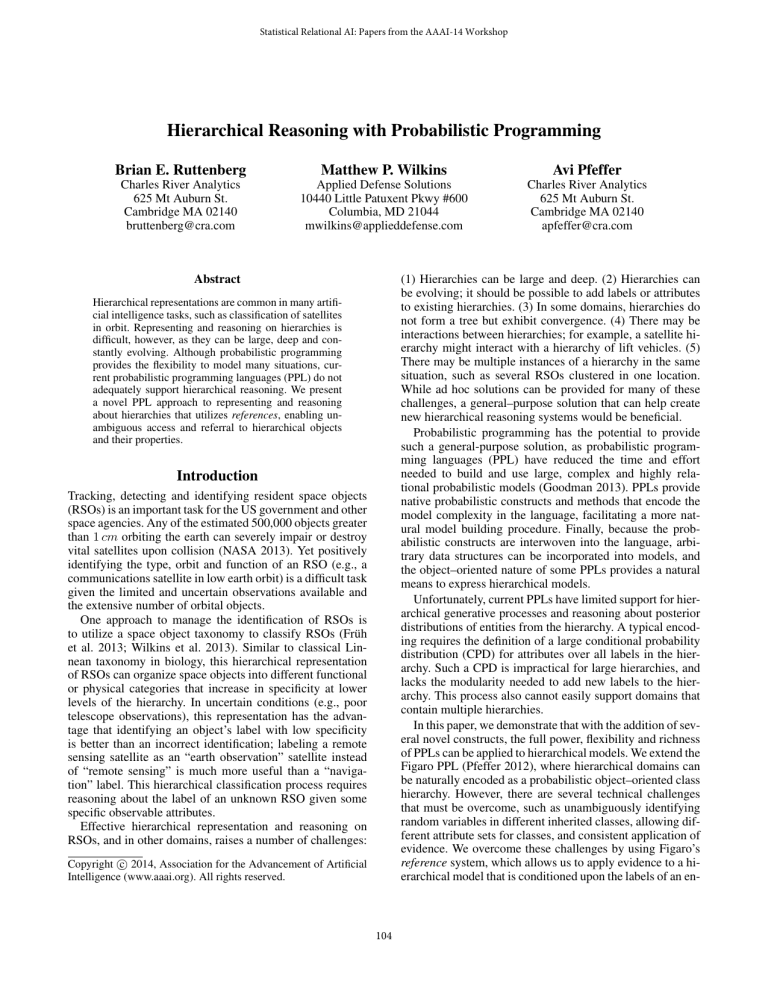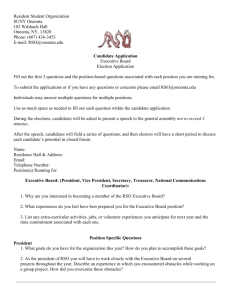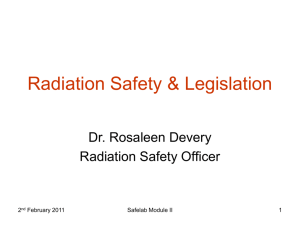
Statistical Relational AI: Papers from the AAAI-14 Workshop
Hierarchical Reasoning with Probabilistic Programming
Brian E. Ruttenberg
Charles River Analytics
625 Mt Auburn St.
Cambridge MA 02140
bruttenberg@cra.com
Matthew P. Wilkins
Applied Defense Solutions
10440 Little Patuxent Pkwy #600
Columbia, MD 21044
mwilkins@applieddefense.com
Abstract
Avi Pfeffer
Charles River Analytics
625 Mt Auburn St.
Cambridge MA 02140
apfeffer@cra.com
(1) Hierarchies can be large and deep. (2) Hierarchies can
be evolving; it should be possible to add labels or attributes
to existing hierarchies. (3) In some domains, hierarchies do
not form a tree but exhibit convergence. (4) There may be
interactions between hierarchies; for example, a satellite hierarchy might interact with a hierarchy of lift vehicles. (5)
There may be multiple instances of a hierarchy in the same
situation, such as several RSOs clustered in one location.
While ad hoc solutions can be provided for many of these
challenges, a general–purpose solution that can help create
new hierarchical reasoning systems would be beneficial.
Probabilistic programming has the potential to provide
such a general-purpose solution, as probabilistic programming languages (PPL) have reduced the time and effort
needed to build and use large, complex and highly relational probabilistic models (Goodman 2013). PPLs provide
native probabilistic constructs and methods that encode the
model complexity in the language, facilitating a more natural model building procedure. Finally, because the probabilistic constructs are interwoven into the language, arbitrary data structures can be incorporated into models, and
the object–oriented nature of some PPLs provides a natural
means to express hierarchical models.
Unfortunately, current PPLs have limited support for hierarchical generative processes and reasoning about posterior
distributions of entities from the hierarchy. A typical encoding requires the definition of a large conditional probability
distribution (CPD) for attributes over all labels in the hierarchy. Such a CPD is impractical for large hierarchies, and
lacks the modularity needed to add new labels to the hierarchy. This process also cannot easily support domains that
contain multiple hierarchies.
In this paper, we demonstrate that with the addition of several novel constructs, the full power, flexibility and richness
of PPLs can be applied to hierarchical models. We extend the
Figaro PPL (Pfeffer 2012), where hierarchical domains can
be naturally encoded as a probabilistic object–oriented class
hierarchy. However, there are several technical challenges
that must be overcome, such as unambiguously identifying
random variables in different inherited classes, allowing different attribute sets for classes, and consistent application of
evidence. We overcome these challenges by using Figaro’s
reference system, which allows us to apply evidence to a hierarchical model that is conditioned upon the labels of an en-
Hierarchical representations are common in many artificial intelligence tasks, such as classification of satellites
in orbit. Representing and reasoning on hierarchies is
difficult, however, as they can be large, deep and constantly evolving. Although probabilistic programming
provides the flexibility to model many situations, current probabilistic programming languages (PPL) do not
adequately support hierarchical reasoning. We present
a novel PPL approach to representing and reasoning
about hierarchies that utilizes references, enabling unambiguous access and referral to hierarchical objects
and their properties.
Introduction
Tracking, detecting and identifying resident space objects
(RSOs) is an important task for the US government and other
space agencies. Any of the estimated 500,000 objects greater
than 1 cm orbiting the earth can severely impair or destroy
vital satellites upon collision (NASA 2013). Yet positively
identifying the type, orbit and function of an RSO (e.g., a
communications satellite in low earth orbit) is a difficult task
given the limited and uncertain observations available and
the extensive number of orbital objects.
One approach to manage the identification of RSOs is
to utilize a space object taxonomy to classify RSOs (Früh
et al. 2013; Wilkins et al. 2013). Similar to classical Linnean taxonomy in biology, this hierarchical representation
of RSOs can organize space objects into different functional
or physical categories that increase in specificity at lower
levels of the hierarchy. In uncertain conditions (e.g., poor
telescope observations), this representation has the advantage that identifying an object’s label with low specificity
is better than an incorrect identification; labeling a remote
sensing satellite as an “earth observation” satellite instead
of “remote sensing” is much more useful than a “navigation” label. This hierarchical classification process requires
reasoning about the label of an unknown RSO given some
specific observable attributes.
Effective hierarchical representation and reasoning on
RSOs, and in other domains, raises a number of challenges:
Copyright c 2014, Association for the Advancement of Artificial
Intelligence (www.aaai.org). All rights reserved.
104
tity. We demonstrate that we can build a large RSO hierarchy
and effectively reason using the hierarchy for identification
of real satellites.
parameter is 0.9. Elements can be passed to other elements
as arguments, and a program typically consists of some number of element definitions.
One essential element in Figaro, the Chain element, captures sequencing of a probabilistic model by chaining the
generation of one element with the generation of a subsequent element that depends on the first element. In Bayesian
network terms, a Chain’s first argument represents a distribution over the parent of a node, while the second argument
is essentially a conditional probability distribution over the
Chain’s output type given the parent. Using Chain, many
elements can be nested together, allowing a user to quickly
create complex conditional probability distributions.
Background
Hierarchical structures can be found in many domains,
such as social networks (Gupte et al. 2011). In vision
tasks, hierarchical models such as latent Dirichlet allocation (LDA) (Blei, Ng, and Jordan 2003) are frequently
used to model the hierarchical generation of features, regions, or objects in an image (Bakhtiari and Bouguila 2010;
Fei-Fei and Perona 2005). Once learned, the hierarchy can
be used to classify an object into labels with specific semantic meaning, or general labels if such specificity is not possible (Sadovnik and Chen 2012; Marszalek and Schmid 2007).
This type of hierarchical reasoning and classification can be
found in other domains as well, such as text (Sun and Lim
2001) or audio (Burred and Lerch 2003) classification.
Probabilistic programming has recently developed as a
potential solution to the problems associated with the creation of large and complex models. Models created with
these languages tend to be highly modular, reusable, and
can be reasoned with using a built–in suite of algorithms that
work on any model created in the language. These languages
take many different forms; some are functional languages
(IBAL (Pfeffer 2001), Church (Goodman et al. 2008)),
imperative (FACTORIE (McCallum, Schultz, and Singh
2009)), embedded in an existing language (Infer.NET (Microsoft Research 2013), Figaro) or implement their own domain specific language (BLOG (Milch et al. 2007)).
There has, however, been little effort expended so far to
support hierarchical reasoning in PPLs. Hierarchical representations are implicitly supported in these languages
via traditional conditional dependence. While PPLs provide
flexible means to create chains of conditional distributions,
the size of these hierarchies can make such a method even
impractical for PPLs, and does not address situations where
entities that share a common label may contain varied attributes. Work by Kuo et al. (2013) and prior work on hierarchical relational models (Newton and Greiner 2004) has
tried to address some of these issues for ontology–based
models. These works mostly proposed representations and
reasoning on the model when relationships in the ontology
are dependent on attributes that may not exist in some entities. While these works presented some solutions to these
problems, they do not provide a PPL framework for reasoning about hierarchies.
Hierarchies
We first formally define a probabilistic hierarchy, and then
subsequently provide examples of several problems with hierarchical representation in PPLs.
Formal Definition
Let L = l1 , . . . , ln be a set of n category labels. A hierarchy H is a partial ordering of L that defines the hierarchical
structure of the labels, where ln is the top label in the hierarchy, and li lj means that li is a sub–label of lj . We denote
a global set of m attributes A = {a1 , . . . , am } for all labels
in the hierarchy. Each label li , however, contains only a subset, Ai ✓ A, of attributes, where ak|i is a random variable
that defines a distribution for the k th attribute from A given
label li . If a label li contains an attribute ak , all of its sub–
labels must contain ak . However, the support or distribution
of ak in different labels may be different.
We also define a generative process for each label lj . We
denote a random variable gj for each lj , where
⇢
pi if li lj
P (gj = li ) =
0 otherwise
As li li , this means that the generative process for a label
can also have non–zero probability of generating itself as a
label instead of any of its sub–labels. In other words, this
process allows instances of internal labels of a hierarchy, as
opposed to just the leaf labels. Since ln is the top level label
in the hierarchy, we can denote gn as the random variable
that samples any label from the hierarchy.
An instance I = (y, x1 , . . . , xk ) represents a sample
from the label generative process and subsequently from
the attribute generative process, where y ⇠ gn , xi ⇠ ai|y .
This definition of a hierarchy is highly flexible and allows
for a diverse representations
(e.g., we do not enforce that
R
P (ak|j = x) = li :li lj P (ak|i = x) P (li |lj )).
Figaro Programming Language
Figaro is an open source, object–oriented, functional programming language implemented in Scala. In Figaro,
models are Scala objects that define a stochastic or
non–stochastic process. The basic unit in Figaro is the
Element[V] class, parameterized by V, the output type
of the element. An element is basically a unit that contains some value based on a random process. For example,
Geometric(0.9) is an Element[Int] that produces
an integer output according to a geometric process whose
Hierarchies in PPLs
Consider the example hierarchy shown in Fig. 1 that shows
a possible hierarchical organization of RSOs. The top label
is RSO, which is divided into Geosynchronous Earth Orbit
(GEO) and Low Earth Orbit (LEO). GEO is divided into two
additional labels for communications and observation satellites. The generative process of the hierarchy is also shown.
105
attribute could be defined for the first time in a class, or it
could inherit or override the distribution of its parent. For
example,
RSO
P(LEO | RSO) = 0.6
LEO
P(GEO | RSO) = 0.4
GEO
abstract class RSO { val attitude: Element[Symbol] }
class LEO extends RSO {
val attitude = Constant(’spinStable) }
P(Comm | GEO) = 0.3
P(Obs | GEO) = 0.1
Communications
Observation
Figure 1: An example RSO classification hierarchy. The
probabilities shown are conditioned upon the parent label.
Note that it is implied that a generic GEO label is generated
with 0.6 probability (since the sub–labels of GEO do not account for all the probability mass).
It is easy to create a naive version of this hierarchy in a
PPL. First, we encode the generative process of the labels as
Figaro functions:
def rso() = Dist(0.6 -> leo(), 0.4 -> geo())
def geo() = Dist(0.6 -> Constant(’geo),
0.3 -> communications(), 0.1 -> observation())
def communications() = Constant(’communications)
def observation() = Constant(’observation)
def leo() = Constant(’leo)
where Dist is a categorical distribution over elements. Note
Scala uses type inference, so explicit declaration of types can
usually be omitted.
Next, we create a process for the attributes of an RSO, in
this case the attitude of the object:
def attitude(v: Element[Symbol]) = CPD(v,
’leo
-> Constant(’spinStable),
’communications -> Constant(’nadir),
’observation
-> Constant(’stable),
’geo -> Select(0.25 -> ’uncontrolled, 0.75 -> ’stable))
Select is Figaro’s notation for a categorical distribution.
Reasoning about an instance from the hierarchy based on observed evidence is quite simple. We create an instance from
this hierarchy by generating a label and an attribute distribution:
creates a class for LEO by extending the RSO class, and we
can change the generative process accordingly (i.e., to generate classes instead of symbols). This encoding also poses
challenges, however. The problem is that now, instead of a
single random variable (RV) representing the attitude of an
RSO, all instances of RSO contain attitude RVs, so there
are four RVs in this model (one for each possible value of
myRSO).
It then becomes problematic to try to refer to the attitude of myRSO. A naive approach would be to use
myRSO.attitude, but this is not correct. myRSO is an
Element[RSO], i.e., a RV. It does not have an attitude
attribute; only the values of myRSO do. In addition, consider
if the GEO class also defines a longitude attribute, but the
LEO class does not. A system using this hierarchy might observe an RSO at a specific longitude, but this information
cannot be asserted on myRSO because the RSO class does
not have a longitude attribute (only the sub–class GEO does).
Figaro’s Chain construct provides a possible solution
to both these problems. We could write Chain(myRSO,
(v: RSO) => v.attitude) to refer to the attitude of
myRSO. However, this solution has the obvious problem that
the entire hierarchy has to be hardcoded, losing the modularity benefits we have worked to achieve. In addition, this solution is highly sub–optimal for inference, as the Chain couples together the RVs for all the different classes. This has
negative implications for both factor and sampling–based inference algorithms.
References
To solve this problem, we use references. References are an
abstraction to access, modify and reason about Figaro elements in a model. A reference can refer to different RVs
depending on the situation, enabling them to overcome the
previous challenges.
val myRSO: Element[Symbol] = rso()
val myAttitude: Element[Symbol] = attitude(myRSO)
where myRSO is an element representing generative process
of the RSO label. At this point, we can apply evidence to the
myAttitude element and perform inference using one of
Figaro’s built–in inference algorithms.
However, this representation is ill suited to represent more
complex hierarchies. There is one large CPD with a case
for each label. This results in a large and unwieldy CPD,
especially with multiple non–independent attributes, where
the dependencies between attributes in different labels must
all be encoded in the same CPD. Furthermore, with each new
label, the CPD must be rewritten, so a user cannot extend the
hierarchy without modifying its core. In addition, the CPD
of an attribute must define a distribution for every label, even
if the label does not contain the attribute.
Clearly, an object-oriented representation with inheritance would be a more modular solution. We could define
a set of classes, each of which contains its attributes. An
Element Collections and Names
To enable references, we enforce that every Figaro element
must have a name, which is just a string handle for the element. String names do not need to be unique, and when none
is provided at element creation, the empty string is used. We
also add element collections (EC) to Figaro. ECs are simply a way to organize Figaro elements into coherent groups.
Every Figaro element is part of an EC; if an element is not
explicitly placed into an EC at creation time, it is placed into
the default EC.
To further explain this concept, we modify the RSO hierarchy with names and ECs as shown below:
abstract class RSO extends ElementCollection {
val attitude: Element[Symbol]
}
class LEO extends RSO {
106
enhancing the modularity and reusability of hierarchies for
multiple purposes.
Using references, it is also not required that every class
representing a label contains a definition for every attribute.
Each class need only to define the attributes that the label
actually contains, regardless of the other attributes in the hierarchy. So, for example, we can add a longitude attribute
for only GEO objects as
val attitude =
Constant(’spinStable)(‘‘attitude’’, this)
}
val myRSO = Constant(new LEO)(‘‘myRSO’’, default)
The RSO class extends the EC trait. Any elements (attributes) defined inside a RSO class are placed into an EC
defined by the newly created class. When we define a LEO
class, we also give its attributes a name. When a LEO is instantiated, it will create an element named “attitude” inside
a LEO, and this means that the element belongs to the EC
of the instantiated LEO. Finally, we create a specific instance
of a RSO and give it a name.
class GEO extends RSO {
val attitude = ...
val longitude = Uniform(-180, 180)(‘‘longitude’’, this)
}
Calling default.get(‘‘myRSO.longitude’’) using the declaration of myRSO from above will create a distribution of the longitude of RSOs using only the labels that
have defined a longitude attribute (i.e., only GEOs). Note
that we did not need to modify the LEO or RSO classes to
use this reference.
Using References
A Figaro reference is a string that, when resolved, refers to
the name of an element within some EC. A reference can be
resolved into one of more elements using a recursive procedure. For instance, each EC defines a function called get
that returns the referred element given the current values of
all other elements. So, we can write
Handling Evidence
val rsoAttitude: Element[Symbol] =
default.get(‘‘myRSO.attitude’’)
Evidence and References
In Figaro, evidence can be applied to elements as constraints
or conditions (hard constraints). These are functions from
the value of an element to either a double value (constraints)
or a Boolean value (conditions). Conditions can also be applied using observation notation, which just asserts that the
value of the element must be the observed value.
Figaro allows evidence to be applied to a reference, and
ultimately, to the elements resolved from the reference. Evidence can be applied using the assertEvidence function in the EC trait, where the user must define the type of
evidence to apply to the resolved elements. For example, the
statement:
To resolve the reference and assign rsoAttitude, the element representing the attitude of the RSO, we first retrieve
the element named “myRSO” from the default EC. There
is only one value of this element (a LEO class), which is an
instance of an EC, so we then recursively call get with the
next part of the reference. On the second call, we retrieve the
element named “attitude” in the LEO EC and return it.
In this example, myRSO is a constant, so any reference to
“myRSO” has only one resolution path. If we use the generative process of RSOs as defined earlier, then myRSO could
take on a several values, where each possible value is also an
EC. Resolving the reference “myRSO.attitude” may refer to
multiple elements, each defining their own random process.
In this case, the reference itself defines a distribution of values. That is, P (myRSO.attitude = x) is
Z
P (y.attitude = x|myRSO = y) · P (myRSO = y)
default.assertEvidence(
NamedEvidence(‘‘myRSO.attitude’’, Observation(’stable))
)
asserts the observation that any element that is resolved
by the reference “myRSO.attitude” should have a value of
’stable.
In this situation, however, it is unclear as to how the evidence should be applied to the resolved elements. A naive
solution is to apply the evidence to the currently referred element, i.e., the element returned by get, but is incorrect. As
the Figaro model represents a random process, the current
state of the model may change and the element the reference
refers to may change. For example, if the current value of
myRSO is an instance of LEO class, we cannot apply the evidence only to the LEO class attributes, since the value of
myRSO may change to an instance of GEO, thus changing
the current resolution of the reference.
It seems then that the evidence should be applied to all
possible elements that could be resolved by the reference.
This too, is incorrect. While there are many possible values of myRSO, at any one time, the element’s value is a single instance of RSO. Hence it is incorrect to always condition the attributes of other values of myRSO on the evidence. To see this, consider the observation above that the
y2myRSO
References in Hierarchies
References are a natural means to build, access and reason
on probabilistic hierarchies because they address many of
the issues touched upon in the previous section. First, using
ECs and naming, we do not need to define abstract label
attributes for all attributes where li lj . Meaning, in our
example, the RSO class does not need to contain abstract
elements that refer to all of the attributes of sub–class of
RSO.
This feature is a powerful tool for building hierarchies;
adding a new sub–class to the hierarchy need not modify any
other class definitions or propagate any information “up” the
class hierarchy. Yet accessing the attributes can still be accomplished in a top–down manner using references. That is,
the reference to “myRSO.attitude” does not require that the
RSO class have any encoded knowledge of the sub–classes
where li RSO. This allows anyone to extend the hierarchy without changing any other class definitions, greatly
107
RSO’s attitude is ’stable. ’stable is not a possible
value for the attitude of a LEO. So if we apply the evidence to
LEO.attitude, the evidence will have probability zero,
even if the current value of myRSO is an instance of GEO.
fied when an element’s value dissatisfies the evidence and
the element is the current resolution of a reference.
Using contingent evidence, we can now reason about the
label of a RSO given its observed attributes. For example,
let us assume that an optical telescope detects a RSO and
determines that the RSO’s mass is within a certain range,
and we wish to determine the label of the unknown RSO.
Assuming the generative process and hierarchy previously
described, we can accomplish this now:
Contingent Evidence
To solve this problem, we extend Figaro with contingent evidence. The idea behind contingent evidence is that evidence
should be applied to a resolvable element of a reference only
when the reference is currently resolved to the element. In
other words, contingent evident applies evidence to an element conditioned upon another set of elements taking on
specific values.
Consider the example evidence from above where
we observe that the attitude of an instance of
RSO is ’stable. In this case, we want to assert
that LEO.attitude == ’stable only when
myRSO.isInstanceOf[LEO] == true. In this
manner, we only assert the evidence on references contingent upon the values needed to resolve the reference.
When evidence is asserted using a reference, contingent
evidence is automatically created and applied by Figaro,
without the need for the user to manually specify how to create the contingent evidence (e.g., as above). Creating contingent evidence is a multistep process. First, we have to find all
possible resolutions of the reference. Figaro will recursively
expand the ECs in the reference and find all possible resolvable elements. Next, for each possible element, Figaro will
create a list of contingent elements and the values they need
to take to make the reference resolve to the element. The list
is stored, along with the evidence, in the resolved element.
Finally, for all elements along a resolvable path, Figaro will
assert that they are only allowed to take on values that will
result in a resolvable element. If no value of an element in
the resolution path results in a valid resolution, then assert
the element’s value as null.
The last step is needed to ensure that elements only take
on values that are consistent with the evidence. For example,
if we observe that a RSO’s longitude is 100, and only GEO
classes have a longitude, then we must ensure that myRSO is
never a LEO. We cannot apply the evidence of the longitude
to a LEO (since they do not have one), but the semantics of
the evidence state that the RSO cannot be a LEO, since the
RSO we did observe has a longitude attribute.
During inference on the model, the value of an element
is checked against any evidence and the list of contingent
elements stored for that evidence. For a condition (Boolean
evidence), a value of the element x satisfies the condition if
^
¬( e.value == v) _ x.value == condition.value
val myRSO = rso("r1")
default.assertEvidence(NamedEvidence("r1.mass",
Condition((d: Double) => d > 6700 && d < 7300)))
val alg = MetropolisHastings(50000, myRSO)
alg.start()
We simply create a new instance of an RSO, assert the
condition that the RSO’s mass is between 6700 and 7300 kg,
and run the Metropolis–Hastings inference algorithm. Once
the algorithm is complete, we can query the posterior distribution of the RSO instance.
Experiments
We implemented a large RSO hierarchy to test the utility of
references in probabilistic programming. The Figaro code
below has been modified for space, but the hierarchy and
full code can be found in the supplement.
Hierarchy and Data Set
The RSO hierarchy is based on a recently proposed taxonomy for space objects (Wilkins et al. 2013). At the top level
of the taxonomy is the RSO class, followed by classes that
define the orbit of the object (GEO, LEO, Medium Earth
Orbit and Ellipse). Subsequent to the orbit, RSOs are further
broken down by the general mission type of the object: Observation, Communications, Navigation or Debris. Observation RSOs are further broken down into sub–missions (e.g,
Meteorology). The top level RSO class is defined as
abstract class RSO extends ElementCollection
with Missions {
val attitude: Element[Symbol] = getAttitude(this)
val mass = FromRange(minMass, maxMass)("mass", this)
val distance =
FromRange(minDist, maxDist)("distance", this)
val brightness: Element[Int]
val brightnessRate: Element[Double] }
The attitude, mass and distance of an RSO are defined in
the RSO class, but each sub–class of RSO is free to define
their own distributions of these attributes. The attitude attribute is created from the getAttitude function, which
is defined per the mission of the object (in the Missions
trait). FromRange is Figaro notation for a discrete uniform
distribution.
Unfortunately, these attributes are not directly observable.
When observing an RSO via optical telescopes, one can only
observe the brightness of the object and the rate at which
the brightness is observed (e.g., rapid glints or no glints).
These attributes are conditioned upon the attitude, mass and
distance of the object. For instance, objects that are farther
from earth have less intense brightness, and objects that are
e,v2Cont
where Cont is a list of contingent elements and the values
needed to resolve the reference to element x. These semantics enforce that whenever the values of the contingent elements are not equal to the stored values (needed to resolve
the reference to this element), the condition on the element is
always true. Because of this feature, we can avoid the problem as previously described: Evidence can only be dissatis-
108
Fig. 2 shows the results of the random testing. First, we
computed the expected posterior probability of the correct
satellite label, shown in the first column. Then we computed
the expected posterior probability of each parent label of
the correct satellite label, up to three levels. As expected,
the probability of each parent label increases at lower specificity classifications of an unknown RSO. It is clear, however, that this hierarchical reasoning can be combined with
a decision rule to classify RSOs and possibly acquire more
sensor data. For instance, if an RSO is an instance of an LEO
with high probability, then additional sensor measurements
can be taken to determine the sub–label of LEO more accurately; or if the probability of sub–labels are nearly equally
likely, we can classify the RSO as the parent label instead of
a more specific label.
To highlight the modularity and flexibility of using PPLs,
we performed two additional tests, also shown in Fig. 2.
First, we tested a situation where additional observation capabilities may be available, and if the longitude of an observed RSO can be determined, it is also applied as evidence
to the model. Note that only GEO objects have a longitude,
but application of this evidence to the appropriate objects
is handled automatically. In this scenario, our posterior parent probabilities increased, reflecting the ability of the hierarchical model to reason with additional information when
available, while requiring no changes in representation or
inference. We also took observations from the 15 satellites
encoded into the hierarchy and computed the posterior distributions for those observations. Not surprisingly, the distributions for this test were the highest. As adding new satellites to the hierarchy is extremely easy, this is an effective
means to reason with an expanding catalog of satellites.
0.6
0.5
Probability
0.4
Original
0.3
With Longitude
Satellites
0.2
0.1
0
Class
Up 1 Level
Up 2 Levels
Up 3 Levels
Figure 2: Testing results using the RSO taxonomy
spin stable have more glints than objects that are nadir. Since
these attributes depend upon other attributes, they are not
defined in the top level class (i.e., each sub–class of RSO
must define them).
The RSO hierarchy just provides a taxonomical classification of RSOs. However, to highlight the benefits of using probabilistic programming for hierarchical reasoning,
we also added class definitions for specific satellites in orbit. Using the database of 1047 known satellites compiled
by the Union of Concerned Scientists (Grimwood 2011), we
added class definitions for several satellites by extending existing hierarchy classes. For instance, the GOES13 satellite
is defined as
class GOES13 extends GEO_Observation_Earth_Meteorology{
override val mass = Constant(32)("mass", this)
...
val longitude = Constant(-104.77)("longitude",this)
}
where the satellite definition overrides the parent class values for mass (and other attributes not shown). Note that this
class also defines an attribute longitude that was not defined in the RSO class, as fixed longitudes are only properties of GEO satellites.
Conclusion
We presented a novel approach to representing and reasoning on probabilistic hierarchies in PPLs. Figaro references
and contingent evidence enable flexible and modular probabilistic hierarchies. Hierarchies are easily expanded with
new information, yet still accessed and manipulated without
complete knowledge of the hierarchy. We also demonstrated
the benefits of our approach for RSO classification, which
has the potential to significantly impact the domain.
Due to the benefits of PPLs and references, creation of
many powerful models is possible. One can easily create
models with multiple RSOs that interact with each other, or
create models with interacting hierarchies; the label of an
RSO could also depend upon a hierarchy of body types, for
example. In addition, the modularity and flexibility of this
PPL representation enables easy creation of dynamic models, where we could use the hierarchy to track RSO observations over time. These types of models are targets for future
research in probabilistic programming and RSO detection.
Testing
Currently, sensor resources are a significant limitation to accurate classification of RSOs. Given the large number of
satellites in orbit, sensor resources must be used judiciously
to ensure that observed data is valuable. For example, collecting low quality observations of a poorly lit but identified object instead of potentially high quality observations
of a brightly lit but unknown object is a waste of resources.
Hence, even low–specificity classifications using the RSO
taxonomy can be extremely useful if the classification can
prevent the misuse of further sensor resources. At present,
no other RSO detection and classification scheme uses hierarchical reasoning as a means to triage sensor resources.
As a consequence, we tested the ability of the RSO hierarchy to detect and classify RSOs at different taxonomical classifications. We selected 50 random satellites from
the UCS database, generated observation data from each
satellite, and applied it as a constraint on the brightness
and brightness rate of an unknown RSO. After applying evidence, posterior probabilities of the unknown class label
were computed using the Metropolis–Hastings algorithm.
Acknowledgements
This work was supported by DARPA contract FA8750-14C-0011.
109
References
Newton, J., and Greiner, R. 2004. Hierarchical probabilistic
relational models for collaborative filtering. In Proc. Workshop on Statistical Relational Learning, 21st International
Conference on Machine Learning.
Pfeffer, A. 2001. IBAL: A probabilistic rational programming language. In International Joint Conference on Artificial Intelligence.
Pfeffer, A. 2012. Creating and manipulating probabilistic
programs with Figaro. In 2nd International Workshop on
Statistical Relational AI.
Sadovnik, A., and Chen, T. 2012. Hierarchical object groups
for scene classification. In IEEE International Conference
on Image Processing (ICIP), 1881–1884. IEEE.
Sun, A., and Lim, E.-P. 2001. Hierarchical text classification
and evaluation. In IEEE International Conference on Data
Mining, 521–528. IEEE.
Wilkins, M. P.; Pfeffer, A.; Schumacher, P. W.; and Jah,
M. K. 2013. Towards an artificial space object taxonomy. In
Advanced Maui Optical and Space Surveillance Technologies Conference.
Bakhtiari, A. S., and Bouguila, N. 2010. A hierarchical
statistical model for object classification. In IEEE International Workshop on Multimedia Signal Processing, 493–
498. IEEE.
Blei, D. M.; Ng, A. Y.; and Jordan, M. I. 2003. Latent
dirichlet allocation. Journal of Machine Learning Research
3:993–1022.
Burred, J. J., and Lerch, A. 2003. A hierarchical approach
to automatic musical genre classification. In Proceedings of
the 6th International Conference on Digital Audio Effects.
Fei-Fei, L., and Perona, P. 2005. A bayesian hierarchical
model for learning natural scene categories. In IEEE Conference on Computer Vision and Pattern Recognition, volume 2, 524–531. IEEE.
Früh, C.; Jah, M.; Valdez, E.; Kervin, P.; and Kelecy, T.
2013. Taxonomy and classification scheme for artificial
space objects. In Advanced Maui Optical and Space Surveillance Technologies Conference.
Goodman, N.; Mansinghka, V.; Roy, D.; Bonawitz, K.; and
Tenenbaum, J. 2008. Church: a language for generative
models with non-parametric memoization and approximate
inference. In Uncertainty in Artificial Intelligence.
Goodman, N. D. 2013. The principles and practice of probabilistic programming. In Proceedings of the 40th annual
ACM SIGPLAN-SIGACT symposium on Principles of programming languages, 399–402. ACM.
Grimwood, T. 2011. Ucs satellite database. Union of Concerned Scientists 31.
Gupte, M.; Shankar, P.; Li, J.; Muthukrishnan, S.; and Iftode,
L. 2011. Finding hierarchy in directed online social networks. In Proceedings of the 20th international conference
on world wide web, 557–566. ACM.
Kuo, C.-L.; Buchman, D.; Katiyar, A.; and Poole, D.
2013. Probabilistic reasoning with undefined properties
in ontologically-based belief networks. In Proceedings of
the 23rd International Joint Conference on Artificial Intelligence (To appear).
Marszalek, M., and Schmid, C. 2007. Semantic hierarchies
for visual object recognition. In IEEE Conference on Computer Vision and Pattern Recognition, 1–7. IEEE.
McCallum, A.; Schultz, K.; and Singh, S. 2009. Factorie:
Probabilistic programming via imperatively defined factor
graphs. In Advances in Neural Information Processing Systems, 1249–1257.
Microsoft Research.
2013.
Infer.net api documentation.
http://research.microsoft.com/enus/um/cambridge/projects/infernet/.
Milch, B.; Marthi, B.; Russell, S.; Sontag, D.; Ong, D. L.;
and Kolobov, A. 2007. Blog: Probabilistic models with unknown objects. In Getoor, L., and Taskar, B., eds., Introduction to Statistical Relational Learning. The MIT press.
373.
NASA. 2013. Space debris and human spacecraft.
110





